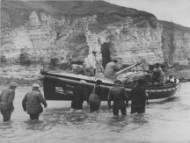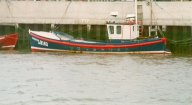 |
 |
The Flamborough Lifeboats |
 |
 |
© Simon Robson
1998-2007
Home
Services
Boats..
Pictures
R.N.L.I
Links
History..
Awards..
"HOWARD D" (O.N. 797) 1948 - 1953
This page was |
Misc. |
| Site Map Copyright |
Awards |
Bronze Medal |
|
Howard D |
 |
Statistics |
Total Service Calls: 14 |
Related |
| Next Boat All Boats Elizabeth Jane Palmer Jason Logg Will & Fanny Kirby Forester Mary Frederick Gertrude No. 2 Station Boats Jane Hannah Macdonald Matthew MiddlewoodSt. Michael's Paddington |
Details from the naming ceremony stated that the boat was designed for use under sail or sail and engine. The boat weighed in at 6½ tons. A six cylinder Weyburn AE6 petrol engine drove a 19½ inch by 17 inch pitch shrouded propeller, developing 35 b.h.p. This gave a maximum speed of over 7 knots. The hull was a double skin, diagonally laid mahogany separated by a layer of calico. This was divided into six watertight compartments, which were packed with 130 air cases. This system enabled the lifeboat to shrug off the water from swamping in 12 seconds. The boat was fitted a line throwing pistol and search light. In October of 1945 she had been fitted with a radio-telephone and loud hailer.
Whilst stationed at St. Helier, "HOWARD D" had been involved in services to vessels carrying out the evacuation of troops from St. Malo, France during June 1940. With the threat of invasion so close the Royal National Lifeboat Institution ordered both Channel Islands lifeboats to evacuate to Cowes, but a crew could not be found for "HOWARD D". Guernsey's, St. Peter Port lifeboat was instructed to go and pick her up, but when they were 2 miles west of St. Helier they were machine gunned by a German aircraft. This unfortunately resulted in the Coxswain's son, Harold Hobbs being killed. The Bailiff of Jersey then made a request to Lifeboat Head Quarters to keep the St. Helier lifeboat on station. This was on the 29th June 1940 and nothing further was heard of "HOWARD D" until June 1943 when a note printed on German Red Cross paper was received from the Honorary Secretary. It read "Greetings to all. Often go out with Howard, Dee and the boys. Howard sends his regards to Groves and Guttridge and hopes to see them soon." This conveyed the lifeboat was well and still on station, Groves and Guttridge was where the boat was sent for refitting.
During the occupation of the Channel Islands the lifeboat was kept afloat. She was manned by a Jersey crew but under strict control from German guards. As record keeping was forbidden, not all services were recorded. It is recorded that she launched 9 times before occupation, saving no lives, 5 times during occupation, saving 35 lives, and 8 times after occupation, saving 11 lives.
 Whilst on station at Flamborough, it is recorded that "HOWARD D" launched on service 14 times and saved the lives of 20. She was transferred to the Arbroath station in 1953, where she served for another 3 years. She was eventually sold out of service to the Coxswain of the Wells in Norfolk, lifeboat. Her bulwarks were raised by 18 inches, renamed to "SPERO II", and was used for whelk fishing.
Whilst on station at Flamborough, it is recorded that "HOWARD D" launched on service 14 times and saved the lives of 20. She was transferred to the Arbroath station in 1953, where she served for another 3 years. She was eventually sold out of service to the Coxswain of the Wells in Norfolk, lifeboat. Her bulwarks were raised by 18 inches, renamed to "SPERO II", and was used for whelk fishing.
Notable Services | |
10th June 1953 | - To the trawler "RIVIERE" of Grimsby (collision), saved 3 and recovered a body. |
28th May 1953 | - To the keel boat "MAY LILY" of Bridlington (engine failure), saved 4 and vessel. |
3rd June 1952 | - To a swimmer in difficulty in Thornwick Bay, saved 1. |
- To a boy over the cliff, assisted to save 1. | |
17th April 1951 | - To the keel boat "MAY LILY" of Scarborough (engine failure), saved 4 and vessel. |
5th July 1950 | - To the fishing coble "PIONEER" of Flamborough (engine failure), saved 5 and vessel. |
17th December 1949 | - To the fishing coble "BRITTANIA" of Flamborough (engine failure), saved 3 and vessel. |

Designed by Simon Robson ©1998-2007
Helmsman - Flamborough Lifeboat Station